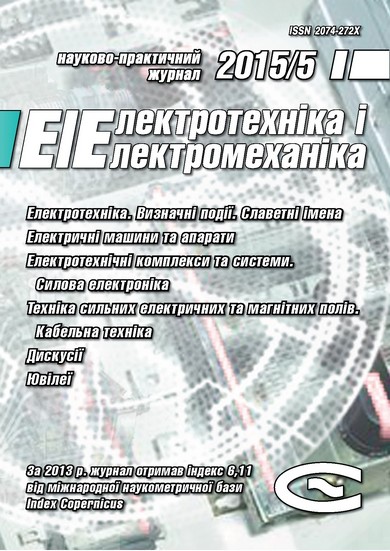DIRECT FREQUENCY CONVERTER WITH ARTIFICIAL AND NATURAL COMMUTATION FOR BRUSHLESS ASYNCHRONIZED MACHINES
DOI:
https://doi.org/10.20998/2074-272X.2015.5.03Keywords:
brushless asynchronized machine, inverter, diode, transistor, thyristorAbstract
The comparative analysis of direct frequency converters with artificial and natural- switching term of the cyclical control algorithm is presented; the recommendations for their using in brushless asynchronized machines with three-phase winding are developed. Converters with a limited number of full-controlled valves have large losses in safety circuits of gates, they can be used in system of automatic excitation control. The best quality of voltage and current load are provided by converters with natural commutation using modulated input voltage, the combined potential compounds windings supply and the combined method of thyristor controlling. When the load is divided into two three-phase groups, an even number of phases of the power supply for single phase of the load are applied the bridge converter circuit. Regulation of the load current is carried out by the excitation current of field exciters and by the control angle of thyristor. Converters can be used in high-power asynchronized motors and generators. In asynchronized compensators it is possible to use diode-thyristor converters without transmitting the control signals to the rotating part. The frequency converters without modulation of input voltage have the smallest increase in rated capacity of power supply. However, they have a low quality form of the output voltage at high power factor of load.References
Shakaryan Y.G., Labunets I.A. Implementation of asynchronous generators and condensers at the facilities of the Unified Energy System. Energetik – Power Engineer, 2005, no.6, pp. 12-19. (Rus).
Abubakirov Sh.I. Experience and prospects of use of asynchronous hydro generators in the projects of LTD «Institute Hydroproject». Gidrotekhnika – Hydrotechnika, 2010, no. 2, pp. 6-11. (Rus).
Savelyev Y.E., Bykov S.V., Zozulin Y.V., Kozlov Y.A. Ustroystvo dlya vozbuzhdeniya asinhronizirovannoy sinhronnoy mashinyi [Device for the excitation of asynchronized a synchronous machine]. USSR Certificate of Authorship, no. 1534744, 1990. (Rus).
Galinovskiy A.M., Lenska E.A., Erhard Ayhofer. Methods of calculating protection circuits valves rectifier. Tekhnichna elektrodynamika – Technical electrodynamics, 2005, no.4, pp. 43-50. (Rus).
Galinovskiy A.M. Research into valve-engine transducers of brushless synchronous and asynchronized machines in a circuit simulation system. Elektrotekhnіka і elektromekhanіka – Electrical engineering & electromechanics, 2013, no.5, pp. 23-29. (Rus).
Galinovskiy A.M., Lenska E.A., Erhard Ayhofer. Research on electric machine valve converters with a limited number of fully-controlled valves. Elektrotekhnіka і elektromekhanіka – Electrical engineering & electromechanics, 2006, no.5, pp. 22-29. (Rus).
Lenska E.A. Frequency converters with forced switching system excitation of asynchronized machines. Elektromekhanichni i enerhozberihaiuchi systemy – Electromechanical and energy saving systems, 2012, no.1, pp. 40-45. (Rus).
Galinovskiy A.M., Dubchak E.M., Lenska E.A. Electric machine valve converters of machines dual power (Part 2). Hirnycha elektromekhanika ta avtomatyka – Mining electrical engineering and automation, 2010, no.85, pp. 159-169. (Rus).
Galinovskiy A.M., Bober V.A., Dubchak E.M. Modes of operation of frequency converters in the proximity of asynchronous machines with infra-low frequency excitation. Elektromekhanichni i enerhozberihaiuchi systemy – Electromechanical and energy saving systems, 2012, no.2, pp. 56-61. (Rus).
Galinovskiy A.M., Beaver V.A. Dubchak E.M. Brushless asynchronous turbine generators with rotary converter in modes of deep consumption and issuance of reactive power. Tekhnichna elektrodynamika – Technical Electrodynamics, 2015, no.1, pp. 72-77. (Rus).
Downloads
Published
How to Cite
Issue
Section
License
Copyright (c) 2015 A. M. Galinovskiy, E. A. Lenskaya, N. P. Melnik

This work is licensed under a Creative Commons Attribution-NonCommercial 4.0 International License.
Authors who publish with this journal agree to the following terms:
1. Authors retain copyright and grant the journal right of first publication with the work simultaneously licensed under a Creative Commons Attribution License that allows others to share the work with an acknowledgement of the work's authorship and initial publication in this journal.
2. Authors are able to enter into separate, additional contractual arrangements for the non-exclusive distribution of the journal's published version of the work (e.g., post it to an institutional repository or publish it in a book), with an acknowledgement of its initial publication in this journal.
3. Authors are permitted and encouraged to post their work online (e.g., in institutional repositories or on their website) prior to and during the submission process, as it can lead to productive exchanges, as well as earlier and greater citation of published work.





